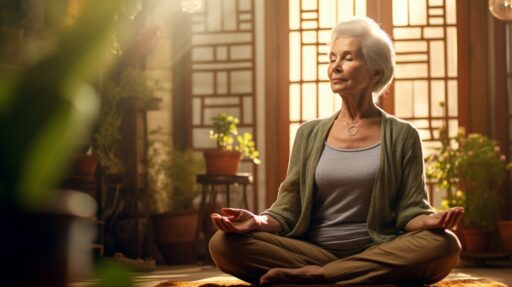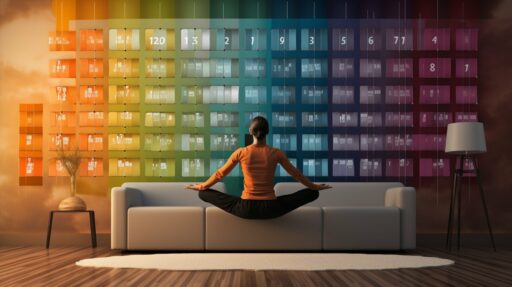Chair Yoga

Chair yoga is a gentle form of yoga that can provide numerous benefits for your physical and mental well-being. Whether you’re a beginner, a senior, or dealing with back pain, incorporating chair yoga into your routine can help improve your posture, increase flexibility, and enhance balance.
In this guide, we’ll explore the basics of chair yoga, including its safety tips, basic poses, and suitability for different groups of people. Let’s dive in!
Key Takeaways:
- Chair yoga is a modified form of yoga that can be practiced while seated, making it accessible for all fitness levels.
- Chair yoga can benefit older adults, individuals with limited mobility, sedentary lifestyles, and chronic health conditions.
- Regular practice of chair yoga can increase balance and flexibility, boost mental well-being, and improve muscle strength and tone.
- Safety tips for chair yoga include practicing mindful movements, avoiding straining, and gradually increasing the intensity.
- Basic chair yoga poses include mountain pose, side bend, knee hug, cow/cat, and warrior 1 & 2.
What Is Chair Yoga?
Chair yoga is a gentle form of yoga that is suitable for all fitness levels. It was developed by yoga instructor Lakshmi Voelker-Binder in 1982 as a way to make yoga accessible to individuals with physical limitations. With chair yoga, you can experience the benefits of yoga while seated, making it a great option for those with limited mobility or who find it difficult to practice traditional yoga poses.
Unlike traditional yoga, chair yoga allows you to perform modified poses while seated in a chair. This modified form of yoga provides support and balance, while minimizing the pressure on your lower joints. It is a safe and effective option for individuals with arthritis, seniors, or anyone looking for a gentle and accessible way to improve their physical and mental well-being.
Chair yoga can help improve posture, increase flexibility, and enhance balance. It also offers mental health benefits, such as reducing anxiety and improving mood. By practicing chair yoga regularly, you can enjoy the benefits of yoga without the need for a yoga mat or specialized equipment. Whether you’re a beginner or an experienced yogi, chair yoga can be a wonderful addition to your wellness routine.

What Is Chair Yoga?
Chair yoga is a gentle form of yoga that is suitable for all fitness levels. It was developed by yoga instructor Lakshmi Voelker-Binder in 1982 as a way to make yoga accessible to individuals with physical limitations. With chair yoga, you can experience the benefits of yoga while seated, making it a great option for those with limited mobility or who find it difficult to practice traditional yoga poses.
Unlike traditional yoga, chair yoga allows you to perform modified poses while seated in a chair. This modified form of yoga provides support and balance, while minimizing the pressure on your lower joints. It is a safe and effective option for individuals with arthritis, seniors, or anyone looking for a gentle and accessible way to improve their physical and mental well-being.
Chair yoga can help improve posture, increase flexibility, and enhance balance. It also offers mental health benefits, such as reducing anxiety and improving mood. By practicing chair yoga regularly, you can enjoy the benefits of yoga without the need for a yoga mat or specialized equipment. Whether you’re a beginner or an experienced yogi, chair yoga can be a wonderful addition to your wellness routine.
Who Should Try Chair Yoga?
Chair yoga is a versatile practice that is suitable for a wide range of individuals, including older adults, those with limited mobility, people with sedentary lifestyles, and individuals managing chronic health conditions. It provides a safe and accessible way to improve overall well-being and enhance physical fitness.
For older adults, chair yoga offers a gentle form of exercise that can help maintain mobility, improve flexibility, and promote healthy aging. The seated poses in chair yoga are designed to reduce the risk of falls and minimize strain on the joints, making it an ideal option for seniors.
Individuals with limited mobility can also benefit from chair yoga, as it allows them to engage in physical activity while seated. The practice helps to improve range of motion, strengthen muscles, and enhance balance, even for those who may have difficulty standing or moving without assistance.
Moreover, chair yoga is especially beneficial for those with sedentary lifestyles and chronic health conditions. It provides a gentle way to introduce movement into their daily routine, helping to reduce the negative effects of prolonged sitting and promote better physical and mental well-being. People managing chronic conditions such as diabetes, arthritis, or back pain can find relief and improved symptom management through the gentle stretches and movements of chair yoga.
Beyond these groups, anyone can try chair yoga and experience its benefits. It is a versatile practice that can be adapted to suit different fitness levels and abilities. Whether you are a beginner or an experienced yogi, chair yoga can be a valuable addition to your fitness routine.

| Benefits | Who can benefit? |
|---|---|
| Increase flexibility | Older adults, individuals with limited mobility |
| Improve balance | Older adults, individuals with limited mobility |
| Manage chronic conditions | People with sedentary lifestyles, individuals managing chronic health conditions |
| Promote healthy aging | Older adults |
| Reduce stress and anxiety | Everyone |
Why Should You Try Chair Yoga?
Chair yoga offers a variety of benefits that can enhance both your physical and mental well-being. By regularly practicing chair yoga, you can increase your balance and flexibility, reduce the risk of falls, and promote independence. It provides a safe and low-impact way to manage chronic conditions like diabetes and arthritis, improving muscle strength and tone. Additionally, chair yoga has been shown to have positive effects on mental health, reducing anxiety and improving mood.
One of the key advantages of chair yoga is its adaptability, making it suitable for individuals of all fitness levels and abilities. Whether you’re a beginner, a senior, or dealing with specific health conditions, chair yoga can be modified to meet your needs. It allows you to engage in yoga poses while seated in a chair, providing support and minimizing the pressure on your joints. This makes it an excellent option for those with limited mobility or physical limitations.
By incorporating chair yoga into your routine, you can experience the benefits of traditional yoga poses without the need to get down on a mat. It offers a convenient and accessible way to improve your overall well-being, regardless of age or physical condition. So why not give it a try? Start your chair yoga journey today and discover the positive impact it can have on your life.

Table: Benefits of Chair Yoga
| Benefit | Description |
|---|---|
| Increase Balance and Flexibility | Chair yoga poses help improve balance and flexibility, reducing the risk of falls and enhancing mobility. |
| Boost Mental Well-being | Regular practice of chair yoga can reduce anxiety, improve mood, and promote overall mental well-being. |
| Manage Chronic Conditions | Chair yoga has been shown to be effective in managing chronic conditions like diabetes and arthritis. |
| Improve Muscle Strength and Tone | By practicing chair yoga, you can strengthen and tone your muscles, particularly important for older adults. |
Chair Yoga Safety Tips
When practicing chair yoga, it’s important to prioritize safety. By following these safety tips, you can enjoy the benefits of chair yoga while minimizing the risk of injury.
Mindful Movements
Practice mindful movements during chair yoga, focusing on how your body feels during each pose. Pay attention to any discomfort or pain and adjust accordingly. Being mindful of your body’s limitations will help you avoid straining or pushing yourself too hard.
Avoid Straining
Avoid straining, jerking, or bouncing during chair yoga exercises. Straining can lead to injuries and muscle strain. Instead, focus on smooth and controlled movements that flow with your breath, maintaining a gentle pace throughout your practice.
Gradual Increase in Intensity
Start your chair yoga practice gently and gradually increase the intensity over time. Allow your body to adapt and become more comfortable with the movements. Pushing yourself too hard too quickly can lead to injuries or unnecessary strain on your muscles and joints.
By following these chair yoga safety tips, you can create a safe and enjoyable practice that contributes to your overall well-being. Remember to listen to your body, be kind to yourself, and always prioritize your safety during your chair yoga journey.

Basic Poses in Chair Yoga
Chair yoga is a versatile practice that offers a variety of poses that can be modified to accommodate the seated position. Incorporating these poses into your chair yoga routine can help improve your posture, increase flexibility, and enhance overall well-being. Let’s explore some of the basic poses in chair yoga:
Mountain Pose
Begin by sitting tall in your chair with your feet hip-width apart. Ground your feet into the floor and engage your core. Lift your crown towards the ceiling and relax your shoulders. This pose helps improve posture and builds strength in the legs.
Side Bend
Sit tall in your chair, ensuring your spine is straight. Extend your arms overhead and interlace your fingers. Lean gently to one side, feeling the stretch along your side body. Hold for a few breaths and then repeat on the other side. This pose helps stretch the oblique muscles and increases flexibility.
Knee Hug
Bring one knee towards your chest and hug it with both arms. Hold for a few breaths and then switch to the other leg. This pose helps release tension in the lower back and stretches the glutes and hip flexors.
Cow/Cat
Sit tall in your chair and place your hands on your thighs. Inhale as you arch your back, lifting your chest and gaze towards the ceiling (Cow pose). Exhale as you round your spine, tucking your chin towards your chest (Cat pose). Repeat the movement, flowing between the two poses. This sequence helps improve spinal flexibility and mobility.
Helicopter
Extend your arms out to the sides at shoulder height, palms facing down. Begin circling your arms forward in a controlled manner, as if you are spinning two helicopter blades. After a few rotations, reverse the direction. This pose helps improve shoulder mobility and increases circulation in the upper body.
Half Forward Fold
Place your hands on your thighs and hinge forward from your hips, allowing your upper body to come towards your thighs. Keep your back straight and hold for a few breaths. This pose helps stretch the hamstrings and lower back.
Reverse Chair
Sit tall in your chair and extend your arms forward at shoulder height. Rotate your palms to face the ceiling and bend your elbows, bringing your hands towards your shoulders. This pose helps strengthen the upper back muscles and improves posture.
Warrior 1 & 2
Start with your feet wide apart, one foot in front of the other. Bend your front knee while keeping your back leg straight. In Warrior 1, raise your arms overhead and look up. In Warrior 2, extend your arms out to the sides and gaze over your front fingertips. These poses help build strength in the legs and improve balance.
Hamstring Stretch
Extend one leg forward and flex your foot. Lean forward from your hips, reaching towards your toes. Hold for a few breaths and then switch legs. This pose helps stretch the hamstrings and improves flexibility.
Gluteal Stretch
Cross one ankle over the opposite knee, flex your foot, and gently press down on the raised knee. Hold for a few breaths and then switch sides. This pose helps stretch the glutes and hips.
Quad Stretch
Hold onto the back of your chair for support. Bend one knee and grab the top of your foot or ankle, bringing your heel towards your glutes. Hold for a few breaths and then switch legs. This pose helps stretch the quads and improves flexibility.
Remember to listen to your body and modify the poses as needed. Chair yoga is a customizable practice that can be tailored to your individual needs and abilities. Enjoy the benefits of these basic poses and discover the joy of practicing yoga from the comfort of your chair.

Chair Yoga for Osteoporosis
If you have osteoporosis, chair yoga can be a safe and effective exercise option for you. Osteoporosis weakens the bone structure, making it important to take precautions to protect the spine during your yoga practice. Chair yoga routines are specifically designed to minimize pressure on the spine, ensuring a gentle and supportive workout.
When practicing chair yoga for osteoporosis, it’s crucial to avoid forward bending from the waist and extreme spinal twists. These movements can put excessive strain on the spine, increasing the risk of fractures. Instead, focus on poses that promote strength, balance, and flexibility without compromising your bone health.
To further protect your spine, it’s recommended to maintain proper posture and alignment throughout your chair yoga practice. Engage your core muscles to support your spine and avoid slumping or slouching in the chair. By practicing chair yoga with caution and following these guidelines, you can enjoy the benefits of yoga while reducing the risk of injury to your spine.
“Chair yoga routines are specifically designed to minimize pressure on the spine, ensuring a gentle and supportive workout.”
Chair Yoga Precautions for Osteoporosis
When practicing chair yoga with osteoporosis, keep the following precautions in mind:
- Avoid forward bending from the waist to prevent excessive strain on the spine.
- Avoid extreme spinal twists that can put pressure on the vertebrae.
- Maintain proper posture and alignment to support the spine.
- Engage your core muscles to avoid slouching in the chair.
- Listen to your body and modify or skip poses that cause discomfort or pain.
Sample Chair Yoga Poses for Osteoporosis
Here are a few chair yoga poses that are suitable for individuals with osteoporosis:
| Chair Yoga Pose | Benefits |
|---|---|
| Seated Spinal Twist | Improves spinal mobility without excessive strain. |
| Seated Side Bend | Stretches the side body and improves flexibility. |
| Chair Warrior I | Strengthens the legs and core muscles. |
| Seated Chest Opener | Opens the chest and shoulders, promoting better posture. |
| Standing Forward Fold with Chair Support | Stretches the hamstrings and calves while supporting the spine. |
Remember, it’s important to consult with your healthcare provider or a certified yoga instructor before starting any exercise program, especially if you have osteoporosis. They can provide personalized guidance and ensure that chair yoga is suitable for your specific condition.
How Often Should You Practice Chair Yoga?
When it comes to practicing chair yoga, finding the right frequency that works for you is key. While there are no official guidelines on how often to practice, the Centers for Disease Control and Prevention (CDC) recommend that adults aged 65 or older engage in strengthening exercises for at least 2 days and balance activities for at least 3 days per week. This provides a good starting point for incorporating chair yoga into your routine.
Beginning with practicing chair yoga twice or three times a week can be a great way to start reaping the benefits. This frequency allows for flexibility in your schedule while still ensuring that you engage in regular practice. However, it’s important to listen to your body and adjust the frequency based on your individual needs and abilities.
Remember, the key is consistency. Regular practice, even if it’s just a few times a week, can help you build strength, improve flexibility, and enhance your overall well-being. So find a schedule that works for you and stick to it. Your body and mind will thank you!

Recommended Guidelines for Chair Yoga Practice:
- Start with practicing chair yoga twice or three times a week.
- Listen to your body and adjust the frequency based on your individual needs and abilities.
- Engage in strengthening exercises for at least 2 days per week.
- Participate in balance activities for at least 3 days per week.
Table: Comparison of Chair Yoga Practice Frequency
| Practice Frequency | Benefits | |
|---|---|---|
| Twice a week | Flexibility and strength improvement | Enhanced overall well-being |
| Three times a week | Increased stability and balance | Reduced risk of falls |
| More than three times a week | Accelerated progress in flexibility and strength | Deeper mind-body connection |
Risks of Overdoing Chair Yoga
While chair yoga offers numerous benefits, it’s important to be mindful of the physical aspect of yoga and avoid overexertion. Overdoing chair yoga can increase the risk of injury and undermine the positive effects of the practice. It’s essential to listen to your body, practice within your limits, and avoid pushing yourself beyond what feels comfortable.
Exerting excessive effort or attempting advanced poses that your body isn’t ready for can strain muscles and joints, leading to discomfort or injury. Remember that chair yoga is meant to be gentle and accessible, making it suitable for people of all fitness levels. It’s important to be patient and gradually increase the intensity of your practice rather than attempting to do too much too soon.
“It’s essential to listen to your body, practice within your limits, and avoid pushing yourself beyond what feels comfortable.”
If you experience any pain or discomfort during chair yoga, it’s crucial to stop the pose and seek guidance from a certified yoga instructor. They can provide personalized modifications and guidance to ensure you’re practicing safely and effectively. By respecting your body’s limits and practicing with moderation, you can enjoy the benefits of chair yoga while minimizing the risk of injury.

Common Injuries in Yoga
| Injury Type | Description |
|---|---|
| Wrist Injury | Excessive weight-bearing on the hands can strain the wrists, leading to sprains or even fractures. |
| Shoulder Injury | Improper alignment or overuse of the shoulder joints can result in strains, rotator cuff injuries, or shoulder impingement. |
| Lower Back Injury | Twisting or bending the lower back beyond its capacity can cause strains, herniated discs, or sciatica. |
| Neck Injury | Forceful or improper neck movements can strain the neck muscles, leading to discomfort or even cervical spine injuries. |
| Knee Injury | Excessive pressure or improper alignment on the knees can result in strains, ligament tears, or patellofemoral pain syndrome. |
How to Do Chair Yoga
Chair yoga is a versatile practice that can be easily incorporated into your daily routine. The best part is, you don’t need any specialized equipment or yoga chairs to get started. Any regular chair will do. To ensure stability, avoid using chairs with wheels. If your feet don’t reach the floor comfortably, you can use blocks or folded yoga mats to provide a firm foundation.
Getting started with chair yoga is simple. You can follow instructional videos or guides that demonstrate specific poses. The key is to focus on adaptability and make the poses work for you. Incorporate the poses that feel comfortable and beneficial for your body, and remember to listen to your body’s signals during the practice. It’s important to start gently and gradually increase the intensity over time.

Whether you’re a beginner or have been practicing yoga for years, chair yoga offers a multitude of benefits for individuals of all fitness levels. It helps improve flexibility, enhances balance, and promotes overall well-being. By incorporating chair yoga into your routine and practicing regularly, you can experience the revitalizing effects right from your seat.
Conclusion
Chair yoga offers numerous benefits for your overall well-being. Its adaptability makes it suitable for individuals of all fitness levels and abilities. By incorporating chair yoga into your routine, you can experience improved flexibility, enhanced balance, and a sense of revitalization.
One of the key advantages of chair yoga is its adaptability. You can practice it using any regular chair without the need for specialized equipment. Whether you’re a beginner, an older adult, or dealing with specific health conditions, chair yoga can be modified to suit your needs and abilities.
Regular practice of chair yoga can have a positive impact on both your physical and mental health. It can help improve your flexibility, strengthen your muscles, and reduce the risk of falls. Additionally, chair yoga promotes mental well-being by reducing anxiety and improving mood.
So, why wait? Start your chair yoga journey today and enjoy the numerous benefits it has to offer. Incorporating chair yoga into your routine will not only enhance your overall well-being but also provide you with a gentle and accessible way to improve your physical and mental health.
FAQ
What is chair yoga?
Chair yoga is a modified form of yoga that allows people of all fitness levels to practice yoga while seated in a chair.
Who can practice chair yoga?
Chair yoga is suitable for a wide range of individuals, including older adults, people with limited mobility, those with sedentary lifestyles, and individuals managing chronic health conditions.
What are the benefits of chair yoga?
Chair yoga offers numerous benefits, including increased balance and flexibility, reduced anxiety, improved mood, muscle strength and tone, and management of chronic conditions like diabetes and arthritis.
Are there any safety tips for practicing chair yoga?
Yes, some safety tips for practicing chair yoga include practicing mindful movements, avoiding straining, and gradually increasing intensity over time.
What are some basic poses in chair yoga?
Basic poses in chair yoga include mountain pose, side bend, knee hug, cow/cat, helicopter, half forward fold, reverse chair, warrior 1 and 2, hamstring stretch, gluteal stretch, and quad stretch.
Is chair yoga safe for individuals with osteoporosis?
Yes, chair yoga routines are designed to minimize pressure on the spine, making it a safe and effective option for individuals with osteoporosis.
How often should I practice chair yoga?
There are no official guidelines, but it is recommended to start with practicing chair yoga twice or three times a week and adjust based on individual needs and abilities.
Are there any risks of overdoing chair yoga?
Yes, it’s important to be mindful of the physical aspect of yoga and avoid overexertion to reduce the risk of injury.
How do I do chair yoga?
Chair yoga can be done using any regular chair without specialized equipment. The key is to focus on adaptability and make the poses work for your body.
What are the overall benefits of chair yoga?
Chair yoga offers a multitude of benefits for individuals of all fitness levels and abilities, including improved flexibility, enhanced balance, and overall well-being.
Chair Yoga
Chair Yoga is a gentle form of yoga accessible to people of all ages and abilities, designed to be practiced sitting on a chair or standing while using the chair for support. This form of yoga can significantly benefit those with mobility issues, older adults, or anyone seeking a low-impact exercise to improve flexibility, concentration, strength, and reduce stress and joint strain.
Benefits of Chair Yoga
- Increased Circulation and Well-being: Chair yoga can enhance circulation, promoting a sense of well-being, and can contribute to decreases in blood pressure, anxiety, inflammation, and chronic pain.
- Flexibility and Strength: It helps stretch and strengthen muscles, improving balance and coordination, which is particularly beneficial for reducing the risk of falls in older adults.
- Reduced Stress and Improved Mental Health: The practice is known for its ability to reduce stress, aiding in mental clarity and emotional calm. It also supports better sleep patterns and overall mental health.
- Accessible and Adaptable: Chair yoga makes the benefits of traditional yoga accessible to individuals at any level of experience, including those who may find regular yoga poses challenging.
